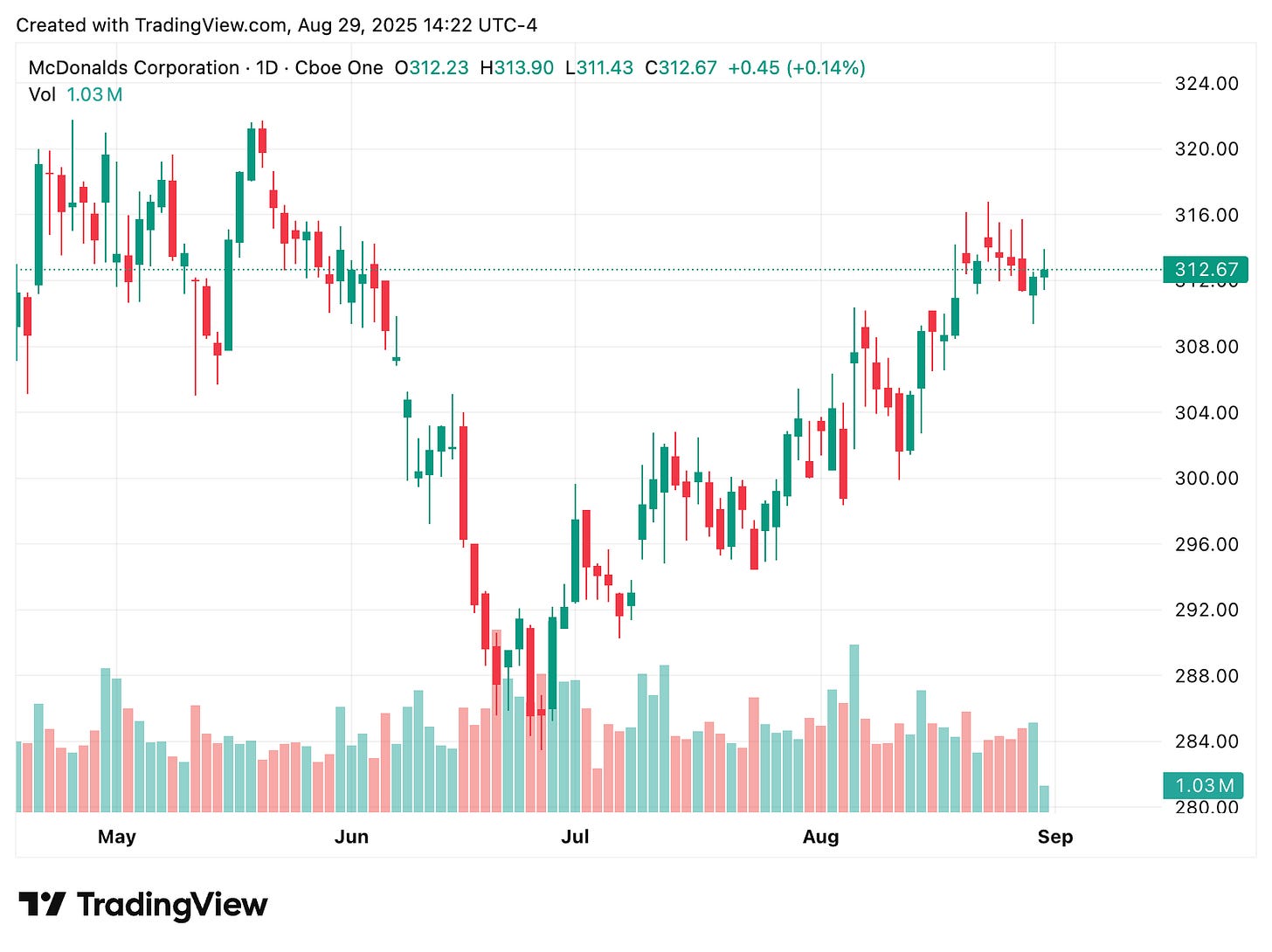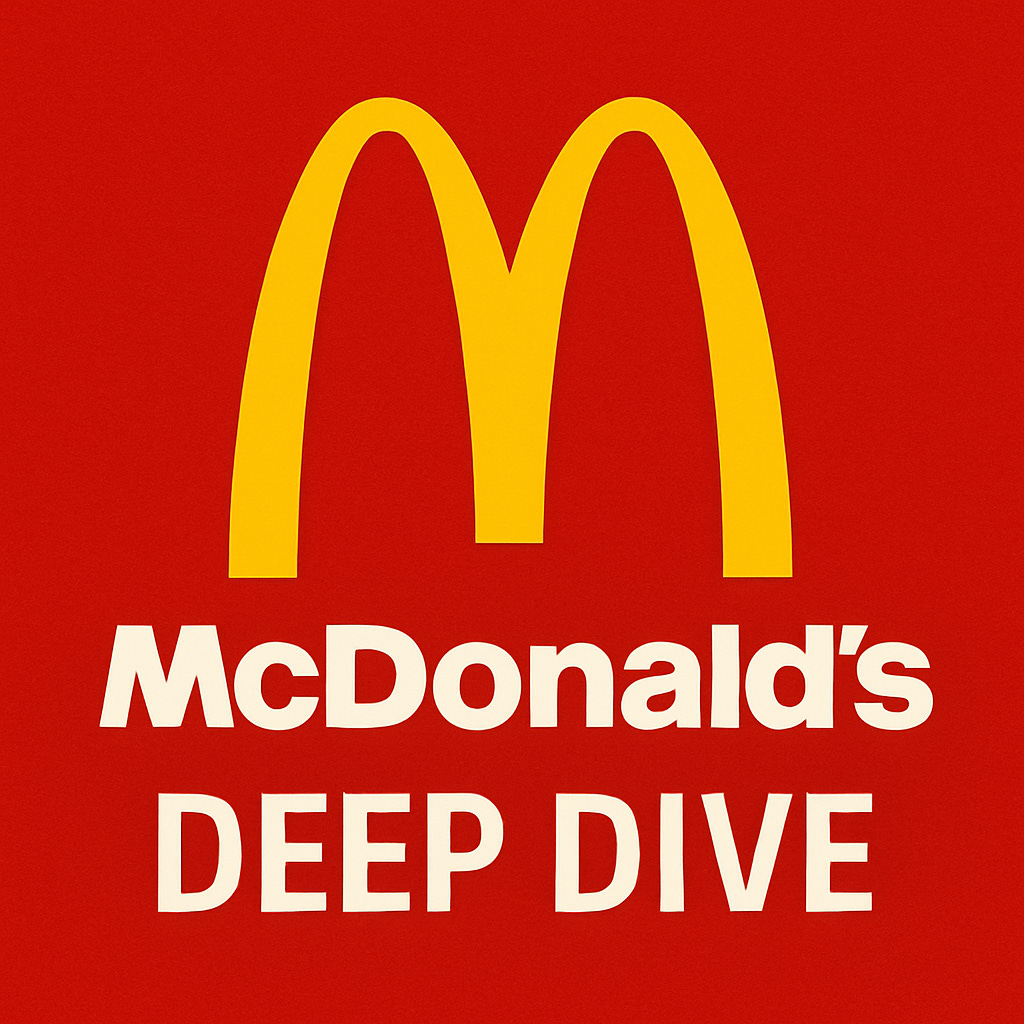McDonald’s (MCD) Deep Dive — Global Scale, Franchising Economics, and the Future of Fast Food
TL;DR (for skimmers)
McDonald’s is the world’s largest restaurant chain by revenue, operating in over 100 countries with more than 40,000 restaurants. Its moat is built on brand ubiquity, franchising economics, real estate ownership, and operational scale. The company is shifting from a food-service operator into a franchise-heavy, asset-light cash compounding machine. Key debates: whether same-store sales can keep pace amid inflation and shifting consumer preferences, the role of technology in efficiency and personalization, and whether McDonald’s can maintain relevance as health, delivery, and digital-first dining reshape fast food. Base case: stable mid-single-digit sales growth, strong free cash flow, and dividend increases, with upside from digital loyalty programs and menu innovation.

1) Identity: From Burger Chain to Global Platform
McDonald’s began in 1955 under Ray Kroc’s franchise model, which remains its defining structure. Today:
93%+ of restaurants are franchised.
The company earns primarily royalties and rent rather than operating profits from company-owned stores.
The real estate model is critical: McDonald’s owns prime locations and leases them back to franchisees, creating an annuity-like cash stream.
This shift makes McDonald’s less about running restaurants and more about managing a global platform of franchisees, supply chains, and brand equity.
2) The Economic Flywheel
Scale: Global advertising, supply chain purchasing power, and real estate leverage.
Franchising: Capital-light expansion with high-margin royalties and rents.
Brand: One of the most recognized in the world, synonymous with consistency and affordability.
Innovation: Drive-thru, McDelivery, kiosks, loyalty apps, and menu updates drive ticket size and traffic.
Cash Flow: Highly predictable, enabling dividend growth and buybacks.
3) Competitive Positioning
Burger King / Restaurant Brands International: Similar franchising model but weaker brand and real estate portfolio.
Yum! Brands (KFC, Taco Bell, Pizza Hut): Diversified brands, but McDonald’s is stronger in breakfast/dayparts and global uniformity.
Quick-service insurgents (Chipotle, Five Guys, Shake Shack): Compete on quality/niche but lack McDonald’s pricing power and ubiquity.
Delivery platforms: Once a threat, now partners—integrated into McDelivery.
McDonald’s advantage: no competitor matches its blend of ubiquity, real estate, and operational scale.
4) Secular Tailwinds
Urbanization & Emerging Market Growth: Middle classes in Asia, Africa, and Latin America demand affordable, consistent food.
Digital Ordering & Loyalty Apps: MyMcDonald’s Rewards creates personalized offers, driving repeat visits.
Delivery Economics: Delivery partnerships expand reach without heavy capex.
Menu Innovation: Localized menus (McAloo Tikki in India, Teriyaki Burger in Japan) drive relevance.
Automation: AI drive-thru voice ordering, kiosks, and kitchen robotics lower labor costs.
5) Risks & Challenges
Health & Nutrition Trends: Shift toward healthier eating and ESG pressure.
Inflation & Labor Costs: Rising wages and input costs can squeeze franchisees.
Consumer Sentiment: McDonald’s must walk a line between value and premiumization.
Regulation: ESG, labor, and supply chain oversight increase compliance costs.
Competition from Fast-Casual: Chipotle and others capture health-conscious, younger demographics.
6) Financial Quality
Revenue: ~$25–27B annually.
Systemwide sales: ~$120B (franchisee + company-operated).
Operating margin: >40% (reflecting franchising model).
Free cash flow: $6–7B annually.
Dividend yield: ~2–3%, with a strong track record of annual growth.
Buybacks: Consistently return excess cash.
McDonald’s is a cash-flow compounder, not a high-growth story. Growth is predictable, margins are robust, and cash return is steady.
7) Capital Allocation
Dividends: Core to investor appeal; McDonald’s is a Dividend Aristocrat with 45+ years of growth.
Buybacks: Aggressively reduce share count, boosting EPS.
Capex: Focused on restaurant modernization (digital kiosks, drive-thru upgrades).
Franchise Investment: Support franchisee economics with remodels and menu innovation.
8) Valuation
Trades at ~22–25x forward earnings, a premium to peers, justified by quality and predictability.
Dividend yield ~2–3%.
Investors buy McDonald’s for stability + modest compounding rather than explosive growth.
9) Catalysts
Digital Engagement: Loyalty program adoption; personalized offers increase ticket size.
Menu Innovation: Limited-time offers (McRib, celebrity meals) create demand spikes.
Emerging Market Growth: Expansion in China, India, and Africa adds long-term runway.
Margin Expansion: Digital efficiencies + franchise scale protect profitability.
ESG/Health Positioning: Reframing menus with healthier items for long-term relevance.
10) Bear Case
McDonald’s loses pricing power amid value wars, franchisees struggle with inflation and labor, and health-conscious consumers defect to fast-casual. In this case, growth slows to GDP-like levels, margins compress, and valuation contracts to ~18–20x earnings. Returns limited to dividend yield + small EPS growth.
11) Bull Case
Digital engagement and loyalty transform McDonald’s into a personalized dining platform, boosting same-store sales sustainably. Emerging markets drive unit growth, zipping past 50,000 stores. AI-driven automation lowers costs, protects margins, and enhances franchisee profitability. In this scenario, McDonald’s sustains high-single-digit EPS growth with dividends and buybacks, justifying a sustained premium multiple.
12) KPI Checklist
Same-store sales growth (SSSG).
Digital sales as % of systemwide sales.
Net new restaurants (global).
Franchisee profitability metrics.
Operating margin trends.
Dividend growth and payout ratio.
13) Portfolio Role
McDonald’s functions as a defensive compounder in portfolios: stable earnings, global exposure, cash returns. It’s a hedge in downturns (consumers “trade down” to value meals) and a steady allocator of capital via dividends and buybacks. For growth-oriented portfolios, it’s slower—but a ballast with upside from digital transformation.
14) Bottom Line
McDonald’s is more than burgers: it’s a global franchising and real estate machine with unmatched brand equity. The future lies in combining its scale with digital personalization, automation, and emerging market expansion. It will not grow like tech, but it will continue to quietly compound shareholder value while paying reliable, growing dividends.
One-liner takeaway: McDonald’s isn’t just fast food — it’s one of the world’s most reliable cash compounding platforms, evolving into a digital-first, globally dominant consumer brand.



